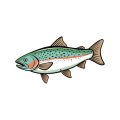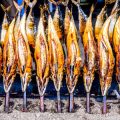Introduction: America’s Secret Waterways
Across the vast and varied landscape of the United States, countless rivers and streams quietly meander through forests, prairies, and rugged canyons—many of them hidden from the mainstream angling community. These secret waterways are more than just scenic wonders; they are thriving habitats for a diverse range of game fish species, from elusive wild trout to feisty smallmouth bass. For anglers seeking a break from crowded lakes and well-trodden fishing hotspots, these lesser-known rivers offer both tranquility and exceptional fishing opportunities. Exploring these hidden gems not only provides a chance to connect with unspoiled nature but also rewards patient adventurers with memorable catches and unique stories. Whether you’re in search of trophy-sized fish or simply yearning for a quiet spot to cast your line, America’s secret streams deliver an unparalleled blend of solitude, challenge, and discovery—reminding us that some of the best angling experiences await off the beaten path.
2. Regional Highlights: From the Pacific Northwest to the Southeast
America’s diverse geography hides a mosaic of rivers and streams, each uniquely suited for different game fish. Let’s break down some standout regions where anglers can discover lesser-known but highly productive waters teeming with bass, trout, walleye, and more.
Pacific Northwest
The lush landscapes of Oregon and Washington are famous for their salmon runs, but the region also boasts hidden streams brimming with wild rainbow trout and cutthroat trout. Off-the-map creeks like Idaho’s St. Joe River or Oregon’s Metolius tributaries offer clear water and rugged beauty for fly-fishing enthusiasts.
Key Hidden Spots:
| State | Waterway | Main Game Fish |
|---|---|---|
| Washington | Klickitat River Tributaries | Steelhead, Trout |
| Oregon | Metolius Creek Offshoots | Rainbow Trout, Bull Trout |
| Idaho | St. Joe River Headwaters | Cutthroat Trout |
The Midwest Heartland
The Midwest is peppered with spring-fed streams and hidden rivers that host excellent smallmouth bass, walleye, and northern pike fishing. Wisconsin’s Driftless Area is particularly rich in coldwater streams perfect for trout, while Minnesota’s lesser-known branches of the Root River deliver both solitude and trophy catches.
Key Hidden Spots:
| State | Waterway | Main Game Fish |
|---|---|---|
| Wisconsin | Pine Creek (Driftless) | Brown Trout, Brook Trout |
| Minnesota | Root River South Forks | Smallmouth Bass, Walleye |
| Iowa | Troublesome Creek | Bass, Channel Catfish |
Southeast U.S.
This region is a hidden gem for warm-water species such as largemouth bass, crappie, and sunfish. The Ozarks’ spring-fed streams carve through forested hillsides in Missouri and Arkansas, while Georgia’s mountain creeks offer robust populations of wild trout away from crowds.
Key Hidden Spots:
| State | Waterway | Main Game Fish |
|---|---|---|
| Missouri | Nine Mile Creek (Ozarks) | Largemouth Bass, Smallmouth Bass |
| Arkansas | Piney Creek Tributaries | Bass, Crappie, Bluegill |
| Georgia | Noontootla Creek (Mountains) | Wild Rainbow & Brown Trout |
A Cross-Country Perspective
The U.S. offers a wealth of off-the-grid rivers and streams across every region—each promising unique angling opportunities for adventurous fishers willing to explore beyond the popular spots. Whether you’re after trout in icy headwaters or bass in mossy southern creeks, there’s always a new hidden waterway to discover.
![]()
3. Local Legends: Unique Fish Species and Folklore
Every hidden river and stream in the U.S. has its own cast of characters—both aquatic and human. From Vermont’s Otter Creek to the winding tributaries of the Pacific Northwest, anglers whisper stories of elusive fish that seem almost mythical. In the South, tales abound about the ghostly Alabama Sturgeon, a rare species whose sightings spark excitement among local fishermen. Meanwhile, up north, the legend of the “Golden Trout” found only in remote California streams draws adventurers hoping to catch a glimpse of its shimmering scales.
Local folklore often weaves together fact and fiction, adding color to fishing trips and creating a sense of community among those who frequent these secret spots. Stories of record-breaking smallmouth bass in Missouri’s Meramec River or the legendary brook trout of Maine’s wild brooks are passed down through generations, inspiring both awe and friendly rivalry.
In addition to these larger-than-life stories, many hidden waterways are home to unique native species you won’t find anywhere else. The Apache trout quietly swims the cool streams of Arizona, while in Texas, rare Guadalupe bass lurk beneath overhanging branches. Each state has its own “local celebrity” fish, often celebrated with annual festivals or fishing tournaments that attract locals and travelers alike.
Whether you’re drawn by folklore or simply the thrill of discovering something new, exploring these lesser-known rivers offers more than just a chance at a big catch—it’s an invitation into the heart of American angling culture. These waters connect us not only to nature but also to the stories and traditions that make each region unique.
4. Angling Strategies and Essential Gear
When it comes to fishing in the hidden rivers and streams across the U.S., preparation and adaptability are your best friends. These remote waterways often require a different approach compared to larger, more accessible bodies of water. Below, youll find practical advice on how to get there, what gear you should pack, and which techniques work best throughout the year.
Accessing Remote Waterways
Getting to secluded streams can be half the adventure. Always check access rights—many hidden gems flow through private land, so secure permission if needed. National forests and public lands often offer legal access points. Consider using lightweight kayaks or inflatable rafts for stretches that are difficult to reach by foot. For hikes, a detailed topographical map and GPS are invaluable tools.
Recommended Tackle for Game Fish
| Fish Species | Rod & Reel | Line | Lures/Bait |
|---|---|---|---|
| Trout | 6-7 ft ultralight spinning rod | 2-6 lb test mono/fluoro | Spinners, small crankbaits, worms |
| Smallmouth Bass | 6-7 ft medium power rod | 8-12 lb test braid/fluoro leader | Soft plastics, jigs, topwater lures |
| Panfish (Bluegill, Crappie) | 5-6 ft ultralight rod | 2-4 lb test mono | Tiny jigs, live grubs, small spinners |
| Northern Pike/Muskie* | 7+ ft heavy action rod* | 20+ lb test braid* | Spoons, large swimbaits* |
*For larger predators found in northern streams; always check local regulations first.
Season-Specific Techniques for Success
| Season | Strategy Tips | Best Times of Day |
|---|---|---|
| Spring | Focus on shallow riffles and pools; fish are active post-spawn. | Dawn & dusk; overcast days best. |
| Summer | Seek shaded undercuts and deeper holes where fish stay cool. | Early morning or late evening; avoid midday heat. |
| Fall | Migratory runs begin; fish become aggressive before winter. | Dawn until mid-morning; late afternoon bite possible. |
| Winter (where open) | Sneak presentations; use slow-moving baits in deep pools. | Midday when sun warms water slightly. |
Pro Tips for Maximizing Your Catch:
- Packing light is key—multi-purpose gear saves weight and space.
- A compact first-aid kit and water filtration device are must-haves for remote outings.
- If targeting multiple species, bring a variety of lures but focus on natural colors that mimic local forage.
The right strategy and gear make all the difference when exploring Americas hidden waters. By planning ahead and adjusting your approach by season, you’ll maximize both your enjoyment and your catch rate on these wild stretches of river and stream.
5. Conservation and Responsible Angling
Preserving the hidden rivers and streams of the United States—those secret waters teeming with game fish—requires a collective commitment to conservation and ethical fishing practices. These pristine habitats are not only vital for thriving fish populations but also for maintaining the ecological balance that supports countless other species. As more anglers discover these lesser-known waterways, its crucial to remember that their continued health depends on responsible use.
A Look at Preserving Hidden Gems
Many of these hidden rivers and streams are particularly vulnerable due to their small size and isolation from larger bodies of water. Overfishing, pollution, invasive species, and habitat destruction can quickly impact these delicate ecosystems. Preserving them means respecting natural boundaries, avoiding littering, and practicing catch-and-release whenever possible to minimize our footprint.
Know the Regulations
Each state—and sometimes each individual waterway—has its own set of regulations designed to protect local fish populations. These may include limits on the number or size of fish you can keep, seasonal closures, gear restrictions, and rules about bait types. Before heading out, always check with your state’s Department of Fish & Wildlife or relevant agency for current regulations specific to your destination. Ignorance isn’t an excuse, and enforcement is taken seriously in many regions.
How Anglers Can Help Maintain Healthy Fish Populations
Responsible anglers play a direct role in conservation efforts. Simple actions like using barbless hooks, properly handling fish during catch-and-release, reporting invasive species sightings, and participating in river clean-ups all make a difference. Supporting local conservation groups or volunteering for habitat restoration projects amplifies your positive impact. By making stewardship part of every fishing trip, we ensure that future generations will have the same opportunities to enjoy these hidden gems across America.
6. Trip Planning: Resources and Community Tips
Embarking on a quest to uncover America’s hidden rivers and streams teeming with game fish is as much about preparation as it is about passion. To make the most of your angling adventure, thoughtful planning is essential. Below, youll find practical guidance on logistics, leveraging local expertise, and connecting with the wider fishing community—all key steps for discovering those under-the-radar fishing gems.
Research and Route Logistics
Start by zeroing in on potential destinations using reputable resources like state wildlife agencies, the U.S. Forest Service, or dedicated fishing apps. Many hidden waterways are tucked away in remote areas—so check access points, parking availability, seasonal road conditions, and any necessary permits. For multi-day trips, map out lodging or campsite options nearby. Always pack for changing weather and bring backup navigation tools since cell service can be spotty in remote locations.
Local Guides: Your Secret Weapon
If you’re venturing into unfamiliar territory or want to maximize your chances of success, hiring a local guide can be invaluable. These pros know the rhythms of their waters—what’s biting, where, and when—and often hold knowledge passed down through generations. Beyond increasing your catch rate, guides help ensure ethical angling practices and can introduce you to unique regional techniques. Check reviews on platforms like Yelp or Orvis Endorsed Outfitters to find trusted professionals.
Connecting with Angler Communities
To gain insider knowledge on hidden streams and rivers, tap into local angler networks both online and in person. Forums such as Reddit’s r/Fishing or region-specific Facebook groups are goldmines for tips on lesser-known spots (just remember: always respect spot-sharing etiquette). Stop by local tackle shops—they’re more than retail spaces; they’re hubs of community wisdom where staff and regulars share current conditions and off-the-map recommendations. Participating in fishing events or conservation volunteer days can also foster connections that lead to valuable intel.
Pro Tip: Respect the Resource
When exploring secretive waters, practice “leave no trace” principles and follow all catch-and-release guidelines if required. By respecting both the land and its locals, you’ll help preserve these special places for future anglers—and keep those hidden rivers teeming with life.


